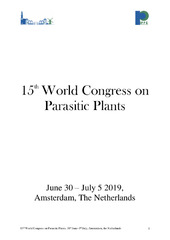Приказ основних података о документу
Breeding strategies for Orobanche cumana resistance in sunflower
| dc.creator | Cvejić, Sandra | |
| dc.creator | Jocić, Siniša | |
| dc.creator | Jocković, Milan | |
| dc.creator | Dedić, Boško | |
| dc.creator | Terzić, Sreten | |
| dc.creator | Imerovski, Ivana | |
| dc.creator | Radanović, Aleksandra | |
| dc.creator | Miklič, Vladimir | |
| dc.creator | Miladinović, Dragana | |
| dc.date.accessioned | 2022-10-06T08:03:19Z | |
| dc.date.available | 2022-10-06T08:03:19Z | |
| dc.date.issued | 2019 | |
| dc.identifier.uri | http://fiver.ifvcns.rs/handle/123456789/3120 | |
| dc.description.abstract | Broomrape (Orobanche cumana Wallr.) is one of the most important constraints on sunflower production in Europe and Asia. It produces a large number of small seeds that are easily disseminated, leading to the build-up of O. cumana populations, and the constant appearance of new, and more virulent races. Current racial situation of broomrape in the main infested areas is unclear, since there is a lack of information on whether races under the same name reported in different countries are the same or differ in terms of virulence. Among the several control options proposed, breeding for resistance have been found to be most effective and environmental friendly way. Since O. cumana resistance is broken frequently, multiple sources of resistance are needed to control the emerging races. In a line with this goal, the Institute of Field and Vegetable Crops Novi Sad has been testing the wild relatives of the sunflower (long-term program) as well as inbred lines in gene bank (short-term program) and identified sources that confer resistance to highly virulent races. Some resistance sources have been found to be controlled by major genes, some have recessive inheritance, but some showed QTL resistance. Race-specific dominant genes are considered as good sources of resistance, but emerging of new races increase the aggressiveness and breakdown vertical resistance. Therefore, pyramiding of more than one resistance gene from different sources into a single genotype would lead to the better ways of achieving durability of resistance. The complexity of host resistance has been also improved using molecular marker analyses for identifying and mapping resistance genes. | sr |
| dc.language.iso | en | sr |
| dc.publisher | International Parasitic Plant Society | sr |
| dc.rights | openAccess | sr |
| dc.rights.uri | https://creativecommons.org/licenses/by/4.0/ | |
| dc.source | (Book of Abstracts), 15th World Congress on Parasitic Plants, 30 June - 5 July 2019, Amsterdam, the Netherlands | sr |
| dc.subject | breeding | sr |
| dc.subject | broomrape | sr |
| dc.subject | Orobanche cumana | sr |
| dc.subject | resistance | sr |
| dc.subject | sunflower | sr |
| dc.subject | breeding for resistance | sr |
| dc.title | Breeding strategies for Orobanche cumana resistance in sunflower | sr |
| dc.type | conferenceObject | sr |
| dc.rights.license | BY | sr |
| dc.citation.epage | 67 | |
| dc.citation.spage | 67 | |
| dc.identifier.fulltext | http://fiver.ifvcns.rs/bitstream/id/8757/bitstream_8757.pdf | |
| dc.identifier.rcub | https://hdl.handle.net/21.15107/rcub_fiver_3120 | |
| dc.type.version | publishedVersion | sr |


